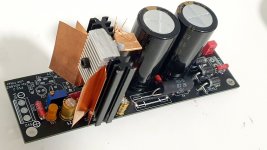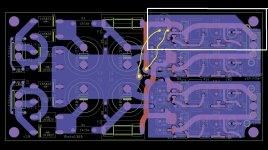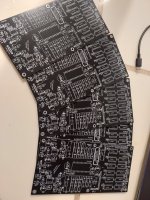@Vavilen You are good to go with the UKW capacitors (they are audio, and audio capacitors have low-esr).
https://www.mouser.sk/ProductDetail/Nichicon/UKW1E101MED1TD?qs=WJSLByB5Mu0A4YfiyBoK/g==
... which version of the PCB do you have? ... if you have the newer (like 1.3) you can fit better capacitors here, UFG or UKZ nichicon ...
220uF UFG: https://www.mouser.sk/ProductDetail/Nichicon/UFG1E221MPM?qs=kArNe9LFxXlwqhduXWzEcA==
330uF UFG: https://www.mouser.sk/ProductDetail/Nichicon/UFG1E331MPM?qs=kArNe9LFxXkpLW6ypRuswQ==
100uF UKZ: https://www.mouser.sk/ProductDetail/Nichicon/UKZ1E101MPM?qs=kArNe9LFxXkz0eA706PMww==
... but what you own now is not bad, you can buy the missing UKW and save money 😉
https://www.mouser.sk/ProductDetail/Nichicon/UKW1E101MED1TD?qs=WJSLByB5Mu0A4YfiyBoK/g==
... which version of the PCB do you have? ... if you have the newer (like 1.3) you can fit better capacitors here, UFG or UKZ nichicon ...
220uF UFG: https://www.mouser.sk/ProductDetail/Nichicon/UFG1E221MPM?qs=kArNe9LFxXlwqhduXWzEcA==
330uF UFG: https://www.mouser.sk/ProductDetail/Nichicon/UFG1E331MPM?qs=kArNe9LFxXkpLW6ypRuswQ==
100uF UKZ: https://www.mouser.sk/ProductDetail/Nichicon/UKZ1E101MPM?qs=kArNe9LFxXkz0eA706PMww==
... but what you own now is not bad, you can buy the missing UKW and save money 😉
Thanks a lot!@Vavilen You are good to go with the UKW capacitors (they are audio, and audio capacitors have low-esr).
https://www.mouser.sk/ProductDetail/Nichicon/UKW1E101MED1TD?qs=WJSLByB5Mu0A4YfiyBoK/g==
... which version of the PCB do you have? ... if you have the newer (like 1.3) you can fit better capacitors here, UFG or UKZ nichicon ...
220uF UFG: https://www.mouser.sk/ProductDetail/Nichicon/UFG1E221MPM?qs=kArNe9LFxXlwqhduXWzEcA==
330uF UFG: https://www.mouser.sk/ProductDetail/Nichicon/UFG1E331MPM?qs=kArNe9LFxXkpLW6ypRuswQ==
100uF UKZ: https://www.mouser.sk/ProductDetail/Nichicon/UKZ1E101MPM?qs=kArNe9LFxXkz0eA706PMww==
... but what you own now is not bad, you can buy the missing UKW and save money 😉
btw, do you think it's a good idea to make a separated PSU for feeding a I2SoverUSB v.III module?
Or no sound improvements comparing to the power supplying over USB?
Proven to sound better with a separate power supply. Same for the WaveIO card I have in DDDAC. If nothing else, the XMOS should be powered by the PC and the output part with the oscillators should have its own +5V 100mA power supply. JLS consumes a little less than 500mA in total, so that's a solid load for a USB port. The XMOS part has power supply stabilizers (3.3V and 1V), while I don't think the output part does, so it's important to power that part at least. In that case, the USB port is loaded with a maximum of 400mA for XMOS, and 100mA is provided separately (say with LM1117T-5.0).it's a good idea to make a separated PSU for feeding a I2SoverUSB v.III module?
If building a separate 5V 400mA power supply for the XMOS part, two things are important. First, it can be 4V 400mA (tried and it works), so that the voltage regulator on the JLS heats up a little less. Second, that part must have a separate secondary on the transformer and be galvanically isolated from the rest, so as not to connect the GND from the PC to the DAC itself. So ground it with say 100nF to the chassis. I used an LM1117T-5.0 and added a single 1A Si diode to the plus line between the supply and JLS to reduce the voltage.
I have had a similar experience with my WaveIo board ( still going strong after ten years). A separate, good power supply makes a big difference, although I don't understand why.
Thanks for sharing your experience!Second, that part must have a separate secondary on the transformer and be galvanically isolated from the rest, so as not to connect the GND from the PC to the DAC itself
Seems that one more PSU2 would be too much for this purpose?
If you've already got a psu1 or 2 you can add another set of outputs pretty easily by tapping the rectified voltage points in the middle of the populated board and running them to a second psu board. On the second psu you populate only the regulator side. The PSUs are designed for more than enough current for a dac, IV stage, and data handling card.
Last edited:
Not at all. You can slice the board in half.Thanks for sharing your experience!
Seems that one more PSU2 would be too much for this purpose?

Or as paddy said, you can even go smaller footprint and cut only +5V part like this and connect to entire psu board.

But you loose the isolated secondary from transformer. I didn't mind the footprint and a little bit more expense, so i went as option numero uno.
Paddy,
but this way he would not be able to use another transformer or secondary, which as nixie62 already said, is important.
but this way he would not be able to use another transformer or secondary, which as nixie62 already said, is important.
The JLS is galvanically isolated between the XMOS and the rest of the circuit. WaveIO too. To keep it that way, a separate secondary and power supply for XMOS is essential.
Separating the PC ground from your DAC is important. A desktop PC is usually grounded directly to house GND and a ground loop can occur. It may or may not. If you are using a laptop or something similar without connection to GND, then this is not a problem.
Another problem is related to the quality of the power supply on the USB connector (its actual power capacity and noise), as well as the USB cable itself that brings that power to the XMOS. To avoid all that, make independent power supplies for both parts of the USB/I2S card.
Separating the PC ground from your DAC is important. A desktop PC is usually grounded directly to house GND and a ground loop can occur. It may or may not. If you are using a laptop or something similar without connection to GND, then this is not a problem.
Another problem is related to the quality of the power supply on the USB connector (its actual power capacity and noise), as well as the USB cable itself that brings that power to the XMOS. To avoid all that, make independent power supplies for both parts of the USB/I2S card.
Last edited:
Better to use separate power transformers (PS too...) only in that case there would not be any coupling at the cecondaries.
because different secondaries on the same transformer still have capacitive coupling, and Coupling factor...
.
OR two battery sets.
because different secondaries on the same transformer still have capacitive coupling, and Coupling factor...
.
OR two battery sets.
One more detail. JLS can only work if the USB cable has all 4 wires, regardless of whether it is powered by a USB port, or has a separate power supply from the DAC. WaveIO works with 3 wires and a separate power supply, so it does not need +5V from the PC. If it is powered by a USB port, all 4 wires are definitely needed
I'm not that much of a fanatic to have all separate toroids for this 😅 Either way, this is serial power supply, unless we put shunt everywhere, not gonna make that much of a difference.Better to use separate power transformers (PS too...) only in that case there would not be any coupling at the cecondaries.
because different secondaries on the same transformer still have capacitive coupling, and Coupling factor...
.
OR two battery sets.
Guys, I am still using the cheapest solution #1694 PCM2706 (only 16-Bit/48kHz with maybe 500mS jitter) for all my R-2R DACs 🤣 🤣 🤣, even though I have different xmos devices, but mostly only for testing 
I like how good the PCM2706 works with mobile (I tested only android OTG), just plug and play (maybe xmos works too but I have not tested yet) ...
(maybe xmos works too but I have not tested yet) ...

I like how good the PCM2706 works with mobile (I tested only android OTG), just plug and play
 (maybe xmos works too but I have not tested yet) ...
(maybe xmos works too but I have not tested yet) ...Miro, these psus and dac boards are great, so many options, so much modularity. You can splurge, or you can go cheap, you can cut slice, add remove, tinker how ever you like, so many possibilitied, and it makes the project at hand so much more fun. Kudos.
@Brijac Thanks 😎 I do my best to achieve many aspects, like the modularity, compactness, diy-friendly, quality or reliability. DAC can be assembled from ordinary components or from premium ones, both options are working.
My intention was to make a high-quality open DAC for the DIY community, in total price for components with box under 500, which can compete with or smash DACs above 5000 🤑🤑🤑
My intention was to make a high-quality open DAC for the DIY community, in total price for components with box under 500, which can compete with or smash DACs above 5000 🤑🤑🤑
- Home
- Source & Line
- Digital Line Level
- DAC AD1862: Almost THT, I2S input, NOS, R-2R
